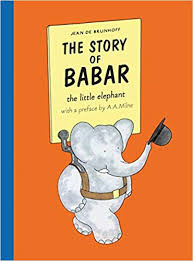Jean de Brunhof and Babar
Listen to the Recess! Clip
| Author | John Cech |
| Air Date | 12/11/2001 |

Jean de Brunhof and Babar Transcript
Jean de Brunhof, who was born this week in 1899 and who became famous for his picture books about Babar the elephant, didn’t actually create the character himself. It was de Brunhof’s wife, Cecile, who first invented a story about a little elephant for her children in 1930. The two de Brunhoff children were so excited about the story that they told it to Papa, and he, an accomplished artist, took over from there, developing the idea and giving the civilized little pachyderm his name. Not even de Brunhoff’s children know how he came up with “Babar.” It is one of life’s mysteries.
Before the Babar books, de Brunhof, who came from a family of art magazine publishers, was an established part of the French art scene. Though he was not an aesthetic revolutionary in his own painting, he did cause a kind of revolution, according to Maurice Sendak, the renowned American artist, in what it was possible to do in the children’s picture book itself. Referring to those extra-large first editions of the Babar books, which are no longer available because of the printing costs, Sendak was amazed by “their huge, delectable formats and grand, spacious compositions” and by the fact that, when they first appeared, children could nearly ‘”climb into” a Babar book’ they were so big. But de Brunhof also brought about a quiet, natural, understated revolution in terms of the seriousness of the content, like the death of Babar’s mother, that could also be included in a picture book.
The books began to be published in 1931, with The Story of Babar, which was soon followed by The Travels of Babar, Babar the King, and Babar and His Children. The stories were immediately successful, and within a few years, de Brunhof was providing designs of Babar for the children’s dining room on the French ocean liner, Normandie. But in the midst of the acclaim, de Brunhoff had also contracted tuberculosis, and by 1937 he had died, leaving two more Babar books nearly finished — Babar and his Children and Babar and Father Christmas. His son, Laurent, would continue the Babar stories after World War II, and in fact Laurent is creating new Babar stories to this day. In children’s books there has probably not been a more profound partnership or a truer continuity of vision than theirs. Jean de Brunhof hardly mentioned his illness. Instead, he has the Old Lady, the voice of wisdom in his books, speak for him when she says, at the end of Babar the King, after a string of calamities: “Do you see how in this life one must never be discouraged? Let’s work hard and cheerfully and we’ll continue to be happy.”